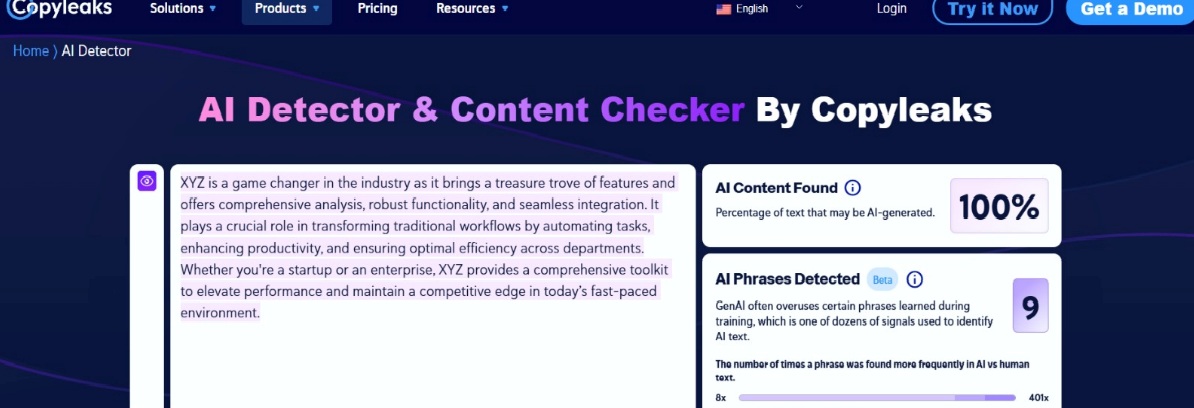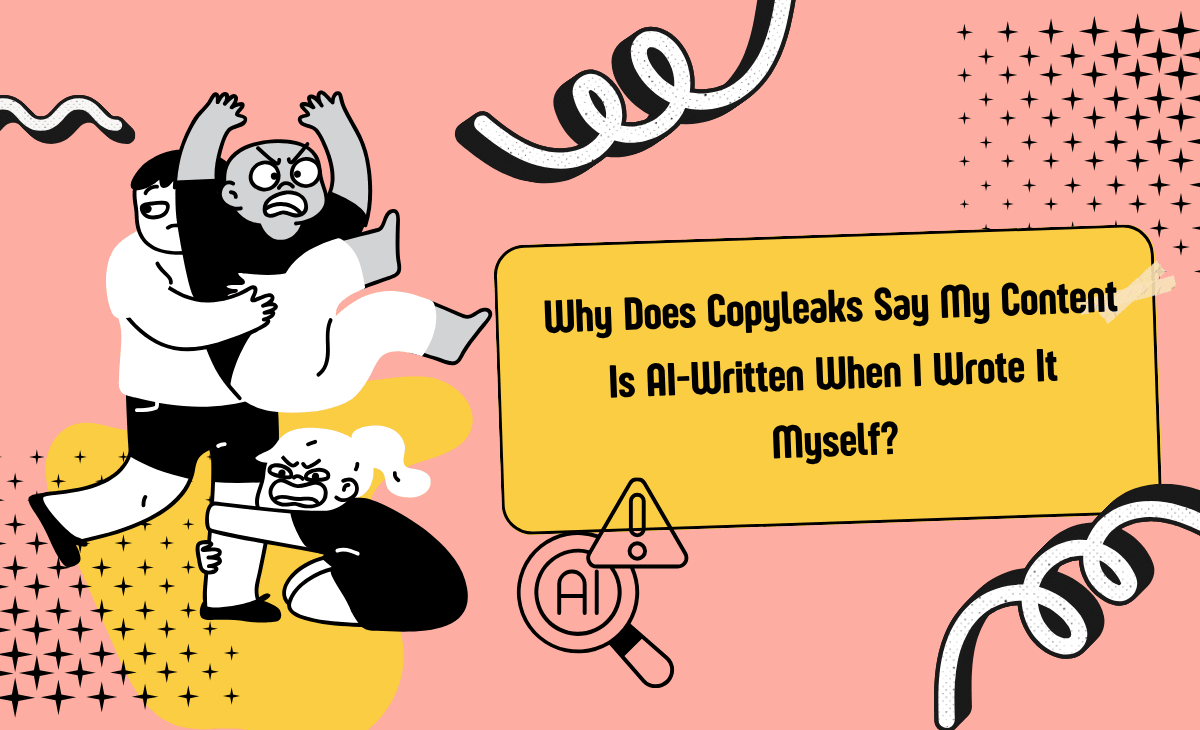Copyleaks was designed to help maintain the integrity of marketing and academic setups. It vouches for protecting intellectual property rights and setting parameters for responsible AI usage. However, that ship sank the moment it started mislabeling human-written content.
The Copyleaks AI detector's false positive rate has now become a serious concern, especially for students and academics. It has reached a point where they fear that each report generated by CopyLeak can disrupt their career.
Things are not easy for marketers either, as when detectors like CopyLeaks wrongly flag human-written content, it leads to mistrust, delays in the approval cycles, and even rejected campaigns.
At this point, we find our writers from every sector defending their creativity rather than focusing on their craft. But how did we end up here, and how do we navigate from this? Let's understand CopyLeaks as a concept to help assess this better.
How Copyleaks Works: The Tech Behind the Detection
Like AI writing tools, a detector also relies on patterns, words, and the usual robotic giveaways to help distinguish between AI-generated and human-written content. This is where the confusion begins, as humans can also write in formal and rigid tones, but we will get into that later. It is critical that we first understand how Copyleaks is known to filter content in detail.
- Identifying Phrases: The first leg of Copyleak’s operations includes identifying phrases that AI is known to rely on. It has to be a sprinkle of “comprehensive analysis”, “plays a crucial role,” “seamless integration,” and others for it to immediately trigger the alarm.
But this is where the contradiction begins, as even human-written content can have these phrases. Think about this from an academic perspective, we need to include a list of overused phrases every now and then to help keep the narrative going.
- Parts of Speech: It then talks about how it is equipped to analyze a sentence for a given text. Now, it is mostly about the structure of your sentences and how you form them. It relies on the fact that human-written content cannot have rigid undertones and always is a mix of complex and simple sentences.
Now, consider this: have you read a blog on a SaaS product? How does it read? Does it read like a story or more of an instructional manual on how the product is efficient enough?
- Syllable Dispersion: This is an interesting concept that Copyleaks uses in its favour to detect the presence of AI. It is a quick check of how many syllables your sentences have on average. This matters because AI tools (like ChatGPT) often use a balanced, predictable mix of short and long words.
But even with syllable dispersion, there is a chance we might be prosecuted, as human creativity doesn’t rely on a fixed calculation of words. Some blogs or papers can have uneven syllable dispersion, and it shouldn’t be the reason for an incorrect markdown.
- Hyphen Use: Not only Copyleaks, but a bunch of other people, too, think that using a hyphen or an em dash is an obvious giveaway for AI-generated work. But hyphens and em dashes have been ruling over our vocabulary ever since the beginning of time.
Fun Fact: Did you know that George Orwell’s 1984 uses em dashes quite generously? Now, imagine flagging one of the greatest writers to ever walk this earth as AI.
But to make sure that Copyleaks is not the ultimate standard for AI detection, I tried my hand at the same. This is how it reacted to a fictional description I wrote for a SaaS tool named XYZ.
Sample Text:
XYZ is a game changer in the industry as it brings a treasure trove of features and offers comprehensive analysis, robust functionality, and seamless integration. It plays a crucial role in transforming traditional workflows by automating tasks, enhancing productivity, and ensuring optimal efficiency across departments.
Whether you're a startup or an enterprise, XYZ provides a comprehensive toolkit to elevate performance and maintain a competitive edge in today’s fast-paced environment.

The results are shocking because, as I had intentionally used some phrases that are known to be AI’s favourite, it flagged my content. A situation like this raises the question of the credibility of thousands of writers who are known to use these phrases.
In fact, some people prefer to keep the narrative as short and crisp as their style of writing. So does that mean they deserve to be flagged or rejected from an opportunity that can change their entire career? Not to mention the sheer panic and frustration that follows with mislabeled content.
Common Reasons Why Copyleaks Flags Human Content
- The text that I pasted in Copyleaks had a deliberate pattern of rigidity. But sometimes you will find that most of our academic documents and papers tend to follow that tone. It follows “perfect” English grammar, followed by next to no personal instances to make a point.
- Phrases like “game changer,” “comprehensive analysis,” “robust functionality,” “seamless integration,” “enhancing productivity,” and “optimal efficiency” are all direct indicators of AI usage with CopyLeaks.
- Apart from these obvious giveaways, there are times when over-optimization with SEO can also lead to CopyLeaks flagging your content. Sometimes we get so engrossed with keyword stuffing that we forget to add relevant context.
- Another common issue is the repetition of sentence structures. If every sentence begins the same way or follows a similar rhythm, the content starts to feel mechanical. Whenever we write, we try to express so many things at once, which is unlikely for machine-generated content. It sticks with one tone and rarely changes the sentences to make a point.
- Usually found in academic writing, we tend to use more of “Moreover,” “In conclusion,” or “It is evident that...” to present ordered ideas or help with a neat transition. This is another giveaway for CopyLeaks, and it tends to associate it with AI.
What to Do If You’re Wrongly Flagged by Copyleaks
Bypassing AI detection can be tricky when you are wrongly flagged. More than the frustration, there is a stress of not being able to meet the set standards. So the first thing you need to do here is not to panic. Being flagged by an AI detector is a compliment in itself. It shows you can attain the grammar and syntax standard set by AI.
But the moment you are calm and collected, the next step in the process is to understand that being wrongly flagged is a miss on Copyleaks' part and not yours. All you now need to do is make a few changes and ensure your writing is completely detection-free.
- Keep Drafts: Maintaining easy access to the drafts for your writing so that you can show them as proof of hand. The idea is to let an editor or checker know your work was developed in stages. It is not a fight against the system, but the most useful way to prove your credibility.
- Contact the Platform: To steer clear of any false accusations that might jeopardize your selection or admission process, you can always get in touch with the authority. But the reason for your contact should be less about the incapabilities of Copyleaks and more about your capability to write to the point as a writer.
- Humanize your Content: If you are skeptical about reaching out to a place, you can always take things into your hands. All you need to do is sit with your paper or blog and start refining the robotic instances, like repetitive phrases and stringent sentences, by yourself. Yes, it can be a bit time-consuming, but it will save you the trouble of detection.
How HumanizeAI.io Can Help Beat Copyleaks’ AI Detection
Manually sitting with a text takes time and effort and can also set you back on your deadline. You need an instant and easy solution that lets you refine your work in one go. This is where Humanize AI comes in as a practical, time-saving alternative.
Instead of rewriting every sentence line by line, Humanize AI helps you shift the narrative towards a more humanized tone at once. But the best part? It doesn’t alter the intent or nature of your voice.
Using Humanize AI gives you the best of both worlds. You get to experience the power of AI, eliminate all the robotic undertones, and still retain your authentic voice.
Be it a blog post, academic assignment, or marketing copy, Humanize AI ensures your writing won’t get flagged for sounding too automated without interrupting your tone or message. All you have to do is take any piece of text you want and let it refine you for detectors like Copyleaks and others.
Do you remember the sample I had written for a fictional brand XYZ that was flagged by Copyleaks? Well, this is what it looks like after Humanize AI did its work:

All it takes is a few refinements here and there, and it could easily convince Copyleaks that the generated text is human. But at the same time, it made sure that the uniqueness of your voice was never compromised.
Whether you're trying to submit a thesis, run a campaign, or pitch to a client, Humanize AI lets you keep your style, just in a format that is acceptable by the detectors.
It’s Time We Humanize the Way We Detect, Too
It is not always about the inconvenience of being wrongly flagged by a detector. More than anything else, it is about the unchecked extent to which automation has gone. A situation like this not only causes panic and mistrust but also undermines the progress we have made with artificial intelligence.
But tools like Humanize AI remind us that there's always a middle path, and we don’t have to be on the wrong side of the debate. As AI becomes more integrated into writing and communication workflows, the goal shouldn’t be to outsmart the detectors alone. It should be about creating content that offers clarity and research that invokes trust.
As the detectors continue to misfire, with false positives on the rise, one must remember that the use of a formal tone, structured grammar, or common phrases is not a sign of AI. The detectors have a long way to go, as they are yet to understand the versatility of human writing. Until then, you must remember that a false label is not what determines your worth as a writer.

